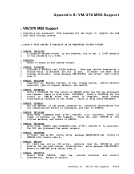If a channel check error is to be recorded, the recorder is entered
atDMKIOERR or DMKIOECC. The channel check handler determines the entry_ A channel check error record is formatted.
A machine check enters atDMKIOEMC. Pointers are passed from the machine check handler in registers 6 and 7 to locate a buffer where the
machine check record and length are saved. Aaachine check error record
is recorded with the savedmachine check logout and additional
information. The machine check error record is written onto the error
recording cylinder by using the paging routines.
Hardware environmental counter records are formed using routineDMKIOEEV. This routine is scheduled by DMKIOS after control is returned
from theERP. Sense data information is stored in the IOERBLOK by the ERP. The record formed is called a nonstandard record. DMKIOEFM is called by DMSIFC (CPEREP command) via a DIAGNOSE instruction. DMKIOEFM 1S invoked to reset the specified error recording
cylinders (if CLEAR, CLEARF, orZERO=Y was specified). The clear is
performed by resetting eachpage-header, space-available field. Pointers in storage are then updated to address the first available page
on each of the error recording cylinders. Control is then returned to
the calling routine. For details on theCPEREP com.and and EREP execution, refer to the !~37Q Q~!~~~ ~nd ~!!~! B~Q£ding Guide and OS/VS EREP publications.
CLEARF on a3031, 3032, or 3033 processor clears the cylinders, then
causes the frame records to be read from theSRF device. DMKIOEFL is called by DMKCPI to find the first available page that can
be used for error recording. The paging routines,DMKRPAPT and DMKRPIGT, are used to read the error recording cylinders' pages
(4096-byte records). As each page record is read, it is examined to see
if this record is the last recorded. If so, a pointer in storage is
saved so recording can continueon that page record. Control is then
returned to the caller. If any error recording cylinder is in an
unrecognizable format, the error recording area is automatically
reformatted byCP. DASD ERROR RECOVERY, ERP (DMKDAS) Error recovery is attempted for CP-initiated I/O operations to its supported devices and for user-initiated operations to CP-supported
devices that use aDIAGNOSE interface. The primary control blocks used
for error recovery are theRDEVBLOK, the IOBLOK and the IOERBLOK. In
addition, auxiliary storage is sometimes used for recovery channel
prograas and sense buffers.
The initial error is first detectedby the I/O interruption handler
whichperforms a SENSE operation if a unit check occurs. Unit check
errors are then passed to an appropriateERP. If a Channel check is
encountered, the channel check interruption handler determines whetherCP Introduction 1-163
at
A machine check enters at
machine check record and length are saved. A
is recorded with the saved
information. The machine check error record is written onto the error
recording cylinder by using the paging routines.
Hardware environmental counter records are formed using routine
from the
cylinders (if CLEAR, CLEARF, or
performed by resetting each
on each of the error recording cylinders. Control is then returned to
the calling routine. For details on the
CLEARF on a
causes the frame records to be read from the
be used for error recording. The paging routines,
(4096-byte records). As each page record is read, it is examined to see
if this record is the last recorded. If so, a pointer in storage is
saved so recording can continue
returned to the caller. If any error recording cylinder is in an
unrecognizable format, the error recording area is automatically
reformatted by
devices that use a
for error recovery are the
addition, auxiliary storage is sometimes used for recovery channel
prograas and sense buffers.
The initial error is first detected
which
errors are then passed to an appropriate
encountered, the channel check interruption handler determines whether








































































































































































































































































































































































































































































